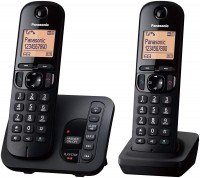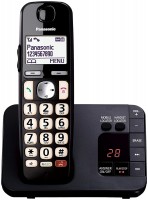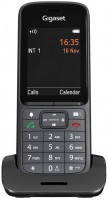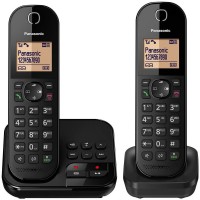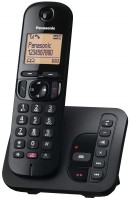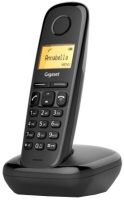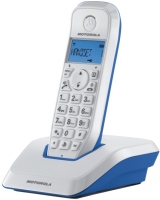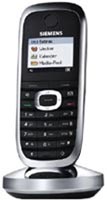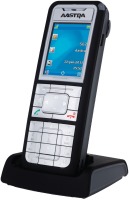Cordless Phones Panasonic
All Cordless Phones Advanced filters → |
You might be interested in
Cordless Phones: specifications, types
Communication standard
The standard by which the radiotelephone handset communicates with the base. To date, there are such options:
— DECT (digital). The standard used in the vast majority of modern radiotelephones. It uses the frequency range 1880 – 1900 MHz or 1920 – 1930 MHz, depending on which region (Europe or USA, respectively) the phone was released. Provides a shorter range than analogue standards, but is considered much more advanced — in particular, due to the high quality of sound transmission, the ability to operate several handsets in close proximity to each other without interference, and the presence of encryption that protects the channel between the handset and the base from unauthorized listening. In addition, the digital data transmission format allows you to use a number of additional features, for example, mini-PBX (communication between two portable handsets, transferring a call to another handset, etc.), support for the GAP standard, which ensures compatibility of handsets and bases from different manufacturers (see "GAP support" for details) and even the transmission of multimedia content.
— 254/380 MHz. An analogue communication standard used in relatively early radiotelephones. Featuring an impressive range (in some models, more than 10 km in open areas), at the same time, this range is inferior to DECT in terms of security, communication quality and additional features; and in itself, the range has recently not been such a significant advantage —...in the light of the spread and cheapening of mobile communications. Therefore, this communication standard is now considered obsolete and is gradually disappearing from the scene.
— 307/344 MHz. Another standard, almost completely similar to the 254/380 MHz described above and differing only in the frequency range used. It can provide even more impressive range performance (more than 20 km), but it has all the signature disadvantages of analogue communications (low immunity to interference and eavesdropping, minimal additional features), and therefore is also used very rarely.
— DECT (digital). The standard used in the vast majority of modern radiotelephones. It uses the frequency range 1880 – 1900 MHz or 1920 – 1930 MHz, depending on which region (Europe or USA, respectively) the phone was released. Provides a shorter range than analogue standards, but is considered much more advanced — in particular, due to the high quality of sound transmission, the ability to operate several handsets in close proximity to each other without interference, and the presence of encryption that protects the channel between the handset and the base from unauthorized listening. In addition, the digital data transmission format allows you to use a number of additional features, for example, mini-PBX (communication between two portable handsets, transferring a call to another handset, etc.), support for the GAP standard, which ensures compatibility of handsets and bases from different manufacturers (see "GAP support" for details) and even the transmission of multimedia content.
— 254/380 MHz. An analogue communication standard used in relatively early radiotelephones. Featuring an impressive range (in some models, more than 10 km in open areas), at the same time, this range is inferior to DECT in terms of security, communication quality and additional features; and in itself, the range has recently not been such a significant advantage —...in the light of the spread and cheapening of mobile communications. Therefore, this communication standard is now considered obsolete and is gradually disappearing from the scene.
— 307/344 MHz. Another standard, almost completely similar to the 254/380 MHz described above and differing only in the frequency range used. It can provide even more impressive range performance (more than 20 km), but it has all the signature disadvantages of analogue communications (low immunity to interference and eavesdropping, minimal additional features), and therefore is also used very rarely.
Bundle
— Handset. The presence of a cordless handset in the delivery set of the phone. This item is mandatory for almost any model (there may be no other equipment in the kit at all). At the same time, for its main purpose, the handset must be connected to the base (see below).
— Base. The presence of the base in the delivery set of the phone. The base is a device connected to the fixed telephone network, like a conventional wired telephone; the cordless handset communicates with the telephone line. Simply put: the radiotelephone can perform its main feature only if there is both a handset and a base.
— Wired telephone. The presence of a classic wired phone in the delivery set, usually connected in parallel with a wireless one. The advantages of such a set are the same as those of an ordinary paired phone: the devices can be placed in different rooms and you can use the one that is closer or more convenient. At the same time, it is usually not a problem to purchase a separate wired phone paired with a wireless one, and there is rarely a real need for such a combination of devices. Therefore, this option is not widely used.
— Base. The presence of the base in the delivery set of the phone. The base is a device connected to the fixed telephone network, like a conventional wired telephone; the cordless handset communicates with the telephone line. Simply put: the radiotelephone can perform its main feature only if there is both a handset and a base.
— Wired telephone. The presence of a classic wired phone in the delivery set, usually connected in parallel with a wireless one. The advantages of such a set are the same as those of an ordinary paired phone: the devices can be placed in different rooms and you can use the one that is closer or more convenient. At the same time, it is usually not a problem to purchase a separate wired phone paired with a wireless one, and there is rarely a real need for such a combination of devices. Therefore, this option is not widely used.
additional handsets
The number of additional cordless handsets supplied with the radiotelephone (in addition to the main handset). Additional handsets usually are also equipped with their own stands, while the features of these stands may be different. So, in some models, they are used only for charging handsets, and the main base is responsible for communication; in others, each stand is a whole separate base. The presence of additional handsets can be convenient in large rooms, for example, in houses with several floors: each handset can be placed on its own floor so you don't have to run up the stairs every time for every phone call. At the same time, buying a set of several handsets is often easier and more convenient than buying them separately.
Indoor range
The maximum range of the phone indoors. Walls act as a rather serious obstacle to radio waves, so the range of a phone indoors is usually much less than in open areas. Usually, the specs indicate the maximum range for a classic office space with medium-sized rooms. In fact, the range depends on many factors (thickness, material and number of walls, floor difference, the presence of interference-producing electronic equipment, etc.) and often turns out to be less than theoretical.
Outdoor range
Handset range outdoors. Usually, the specs indicate the range in line-of-sight conditions, that is, with the complete absence of obstacles between the handset and the base; thus, the outdoor range may be less than claimed due to the presence of obstacles (houses, trees, etc.).
Features
— Android. The phone is running a full Android mobile operating system, created by Google specifically for smartphones and tablet computers. On the one hand, such models perform all the features of a conventional radiotelephone — using the base, the device connects to the telephone network and allows you to make calls to landline numbers, there is a caller ID, answering machine and address book. On the other hand, the device looks like a modern smartphone and has all of its features (sending SMS messages, accessing the Internet, making video calls, listening to music or watching movies, using many different applications and games available through the proprietary Google Play service).
— Answering machine. A device that allows you to receive an incoming call and save a message from the caller if the user is not near the phone at the time of the call or he cannot (or does not want to) pick up the phone. The answering machine turns on if the user does not pick up the handset for a while when an incoming call arrives (a specific turn-on time can be pre-configured). A pre-recorded greeting message is read to the subscriber on the line, usually approximately as follows: “Hello, you called ... (user's first or last name). Unfortunately, I am unable to answer the phone at the moment. Leave your message after the beep”, after which the recording mode is activated and the caller can leave a voice message (for e...xample, introduce himself and ask to call back). Thus, the presence of an autoresponder significantly reduces the likelihood of missing important information. It should be noted that the inclusion of the answering machine occurs with the establishment of a connection, which accordingly affects the billing of the call for the subscriber on the line.
— Caller ID. This is a device that, when an incoming call is received on the phone, requests the number of the caller and displays it on the phone display. Similar to an answering machine, caller ID activation occurs with the actual establishment of a connection, the call fee begins to accrue from this moment, and the user on the line learns about caller ID activation due to a characteristic change in the tone of the dial tone.
— Autodial. This feature allows you to automatically dial a specific number until the other end of the line answers. It is especially useful in cases where the desired number is constantly busy: instead of manually dialing the desired number and manually resetting the call each time the line is busy, the user just needs to set the number and turn on auto redial. Some models may provide additional options for this feature — for example, choosing the interval between attempts to get through or limiting the number of these attempts. In this case, usually, there is no need to hold the handset to your ear — if the connection is successful, the phone will turn on the speakerphone (after which you can turn it off and talk through the handset).
— Caller ID. The CLIP FSK Caller ID standard is an analogue of Caller ID (see Caller ID) used on digital exchanges. It differs, in particular, in that the identification of the number using the Caller ID protocol occurs without establishing a connection.
— Speed Dial. A feature that makes it easier to dial the most frequently used phone numbers. In telephones with speed dialing, such numbers can be stored in the handset or base; each of them will be assigned a sequence number (one-, two- or three-digit), after which telephone numbers can be dialed automatically by simply entering the corresponding sequence number on the keypad.
— Emergency call. A special phone mode, designed primarily for children who do not know how to dial telephone numbers. The phone switched on in this mode automatically dials the previously entered number when pressing any button on the keypad; it may also turn on the speakerphone. Thus, the child left at home will be able, if necessary, to get through to the parents without any problems.
— Bluetooth. The Bluetooth standard is used for wireless communication between various devices over short distances (up to 10 m); however, the devices do not have to be in direct line of sight with each other. In radiotelephones, the Bluetooth module can be used, for example, to connect to a computer or laptop: in this way, you can edit or synchronize the address book, download new ringtones, work with answering machine entries, etc.
— Intercom (internal communication). Possibility of two-way voice communication, usually between handset and base (or handset and handset). In this case, the call "to communicate" can, usually, be sent both from the handset and from the base. Communication in this mode uses only the channel between the handset and the base and does not occupy the telephone line, so there is no risk of missing an external incoming call during such negotiations. This feature can be especially useful if the handset and base are separated by a considerable distance. Another type of intercom is the ability to communicate between separate handsets connected to the same base. This feature is also referred to as "Walkie-Talkie Mode"; see the corresponding glossary item for more details.
— Conference call. Possibility of simultaneous conversation between several people. This can be either a purely “internal” conversation (for example, a user at a base with two users connected to it with handsets, see “Intercom (intercom)”), or a conversation involving an external subscriber on the line. At the same time, phones with conference support usually allow you to turn on this mode after receiving an external call — after answering the call, you can call the user at another handset / base and conduct a simultaneous conversation between three subscribers. This mode is very convenient for organizing meetings.
— Speakerphone. In hands-free mode, the person's voice on the line is reproduced through a special speaker, and the your voice is perceived through a special microphone (such a speaker and microphone can be located both on the handset and on the base of the phone). At the same time, the loudspeaker volume is high enough, and the microphone is sensitive enough so that a conversation can be carried out without bringing the handset to your ear (as an option, without removing it from the base at all). Thus, when the speakerphone is turned on, everyone present in the room gets the opportunity to participate in the conversation, and the user himself gets rid of the need to hold the handset and can, for example, comfortably take notes.
— Jack for the headset. A connector that allows you to connect a wired headset to the handset of the radiotelephone. This allows you to free your hands during a conversation — for example, put the handset in your pocket and conveniently record dictated information. Note that the specific connection interface in different models may be different: some devices use standard formats like a 3.5 mm mini-jack, while others work only with original plugs.
— Support for SMS messages. The ability to use a radiotelephone to send and receive short text messages (Short Message Service, SMS) — similar to those used in most modern mobile networks. To use this feature, the phone must be connected to a digital fixed telephone network that supports receiving and sending SMS.
— Night mode. Phone operating mode intended for night time or when it is necessary that no one disturbs the user (for example, during the sleep of a small child). In this mode, the sound of the call is completely turned off; while the light indication of an incoming call can be preserved. Night mode can be turned on and off both manually and automatically at a pre-set time.
— Baby monitor mode. This mode allows you to listen to what is happening in the room while being in another room. This can be useful, for example, if a small child is sleeping in the room — the Baby Monitor function will allow you not to miss the moment of his awakening. Typically, two handsets are used for this mode: one is placed in the listening room, the second is carried by the user. When there is noise in the room, the user's handset receives a call; answering it, he can listen to what is currently happening in the room.
— Radio mode. A variation of the intercom mode (see Intercom), in which two-way voice communication is carried out between two handsets, bypassing the connection to the base. Like a regular intercom, such communication is carried out via an internal channel, but an external connection will not be available at this moment.
— Black list. The purpose of this feature is generally clear from the name: it allows you to add certain numbers to the list of unwanted ones. When a call is received from such a number, the phone will block the call without notifying the owner (the subscriber on the other end of the line may receive a busy signal, or the call may be dropped). In this way, you can protect yourself from unwanted calls. And some devices with this function also support the "white list" function. It works the other way around: the phone blocks all numbers except those on the list.
— Blocking the dialing of restricted numbers. Ability to block phone calls to specific numbers. It is technically possible to provide the blocking of any set of numbers, up to a specific phone number; however, blocking by number range or type is much more common. For example, by prohibiting calls to numbers starting with "8", you can block the ability to call from a telephone over long distances and to mobile phones; and if you enter a ban on "8 plus operator code", you can restrict access to specific mobile networks. Usually, the lock is protected by a digital password and can only be disabled after entering a given combination.
— Answering machine. A device that allows you to receive an incoming call and save a message from the caller if the user is not near the phone at the time of the call or he cannot (or does not want to) pick up the phone. The answering machine turns on if the user does not pick up the handset for a while when an incoming call arrives (a specific turn-on time can be pre-configured). A pre-recorded greeting message is read to the subscriber on the line, usually approximately as follows: “Hello, you called ... (user's first or last name). Unfortunately, I am unable to answer the phone at the moment. Leave your message after the beep”, after which the recording mode is activated and the caller can leave a voice message (for e...xample, introduce himself and ask to call back). Thus, the presence of an autoresponder significantly reduces the likelihood of missing important information. It should be noted that the inclusion of the answering machine occurs with the establishment of a connection, which accordingly affects the billing of the call for the subscriber on the line.
— Caller ID. This is a device that, when an incoming call is received on the phone, requests the number of the caller and displays it on the phone display. Similar to an answering machine, caller ID activation occurs with the actual establishment of a connection, the call fee begins to accrue from this moment, and the user on the line learns about caller ID activation due to a characteristic change in the tone of the dial tone.
— Autodial. This feature allows you to automatically dial a specific number until the other end of the line answers. It is especially useful in cases where the desired number is constantly busy: instead of manually dialing the desired number and manually resetting the call each time the line is busy, the user just needs to set the number and turn on auto redial. Some models may provide additional options for this feature — for example, choosing the interval between attempts to get through or limiting the number of these attempts. In this case, usually, there is no need to hold the handset to your ear — if the connection is successful, the phone will turn on the speakerphone (after which you can turn it off and talk through the handset).
— Caller ID. The CLIP FSK Caller ID standard is an analogue of Caller ID (see Caller ID) used on digital exchanges. It differs, in particular, in that the identification of the number using the Caller ID protocol occurs without establishing a connection.
— Speed Dial. A feature that makes it easier to dial the most frequently used phone numbers. In telephones with speed dialing, such numbers can be stored in the handset or base; each of them will be assigned a sequence number (one-, two- or three-digit), after which telephone numbers can be dialed automatically by simply entering the corresponding sequence number on the keypad.
— Emergency call. A special phone mode, designed primarily for children who do not know how to dial telephone numbers. The phone switched on in this mode automatically dials the previously entered number when pressing any button on the keypad; it may also turn on the speakerphone. Thus, the child left at home will be able, if necessary, to get through to the parents without any problems.
— Bluetooth. The Bluetooth standard is used for wireless communication between various devices over short distances (up to 10 m); however, the devices do not have to be in direct line of sight with each other. In radiotelephones, the Bluetooth module can be used, for example, to connect to a computer or laptop: in this way, you can edit or synchronize the address book, download new ringtones, work with answering machine entries, etc.
— Intercom (internal communication). Possibility of two-way voice communication, usually between handset and base (or handset and handset). In this case, the call "to communicate" can, usually, be sent both from the handset and from the base. Communication in this mode uses only the channel between the handset and the base and does not occupy the telephone line, so there is no risk of missing an external incoming call during such negotiations. This feature can be especially useful if the handset and base are separated by a considerable distance. Another type of intercom is the ability to communicate between separate handsets connected to the same base. This feature is also referred to as "Walkie-Talkie Mode"; see the corresponding glossary item for more details.
— Conference call. Possibility of simultaneous conversation between several people. This can be either a purely “internal” conversation (for example, a user at a base with two users connected to it with handsets, see “Intercom (intercom)”), or a conversation involving an external subscriber on the line. At the same time, phones with conference support usually allow you to turn on this mode after receiving an external call — after answering the call, you can call the user at another handset / base and conduct a simultaneous conversation between three subscribers. This mode is very convenient for organizing meetings.
— Speakerphone. In hands-free mode, the person's voice on the line is reproduced through a special speaker, and the your voice is perceived through a special microphone (such a speaker and microphone can be located both on the handset and on the base of the phone). At the same time, the loudspeaker volume is high enough, and the microphone is sensitive enough so that a conversation can be carried out without bringing the handset to your ear (as an option, without removing it from the base at all). Thus, when the speakerphone is turned on, everyone present in the room gets the opportunity to participate in the conversation, and the user himself gets rid of the need to hold the handset and can, for example, comfortably take notes.
— Jack for the headset. A connector that allows you to connect a wired headset to the handset of the radiotelephone. This allows you to free your hands during a conversation — for example, put the handset in your pocket and conveniently record dictated information. Note that the specific connection interface in different models may be different: some devices use standard formats like a 3.5 mm mini-jack, while others work only with original plugs.
— Support for SMS messages. The ability to use a radiotelephone to send and receive short text messages (Short Message Service, SMS) — similar to those used in most modern mobile networks. To use this feature, the phone must be connected to a digital fixed telephone network that supports receiving and sending SMS.
— Night mode. Phone operating mode intended for night time or when it is necessary that no one disturbs the user (for example, during the sleep of a small child). In this mode, the sound of the call is completely turned off; while the light indication of an incoming call can be preserved. Night mode can be turned on and off both manually and automatically at a pre-set time.
— Baby monitor mode. This mode allows you to listen to what is happening in the room while being in another room. This can be useful, for example, if a small child is sleeping in the room — the Baby Monitor function will allow you not to miss the moment of his awakening. Typically, two handsets are used for this mode: one is placed in the listening room, the second is carried by the user. When there is noise in the room, the user's handset receives a call; answering it, he can listen to what is currently happening in the room.
— Radio mode. A variation of the intercom mode (see Intercom), in which two-way voice communication is carried out between two handsets, bypassing the connection to the base. Like a regular intercom, such communication is carried out via an internal channel, but an external connection will not be available at this moment.
— Black list. The purpose of this feature is generally clear from the name: it allows you to add certain numbers to the list of unwanted ones. When a call is received from such a number, the phone will block the call without notifying the owner (the subscriber on the other end of the line may receive a busy signal, or the call may be dropped). In this way, you can protect yourself from unwanted calls. And some devices with this function also support the "white list" function. It works the other way around: the phone blocks all numbers except those on the list.
— Blocking the dialing of restricted numbers. Ability to block phone calls to specific numbers. It is technically possible to provide the blocking of any set of numbers, up to a specific phone number; however, blocking by number range or type is much more common. For example, by prohibiting calls to numbers starting with "8", you can block the ability to call from a telephone over long distances and to mobile phones; and if you enter a ban on "8 plus operator code", you can restrict access to specific mobile networks. Usually, the lock is protected by a digital password and can only be disabled after entering a given combination.
GAP Support
GAP(General Access Protocol) is an extension to the DECT standard (see Communication Standard) that provides compatibility between handsets and bases from different manufacturers. Thus, handsets supporting this standard can be easily connected to a base with GAP support, regardless of whether they are from the same bundle or not, whether they are made by the same manufacturer or by another — the main features of the phone, such as dialing and talking, will be available to the user anyway. At the same time, GAP support does not guarantee the possibility of using additional features (for example, managing an answering machine). Also, the GAP protocol allows you to connect several handsets to one base at the same time and vice versa, one handset to several bases.
Handsets supported (base)
The number of handsets that can be simultaneously connected to one radiotelephone base using GAP technology (see above).
If the base supports the connection of several handsets, you can actually organize a paired (triple, quad, etc.) telephone without purchasing additional bases (for which you would have to organize your own connection to the telephone network). And some models may have additional features available, such as handset-to-handset communication (see Features/Specs).
If the base supports the connection of several handsets, you can actually organize a paired (triple, quad, etc.) telephone without purchasing additional bases (for which you would have to organize your own connection to the telephone network). And some models may have additional features available, such as handset-to-handset communication (see Features/Specs).
Bases supported (handset)
The number of bases to which a radiotelephone handset can be simultaneously connected using GAP technology (see above).
Connecting to multiple bases can be useful when you have to deal with several phone numbers, and the call to be answered can come from any of them. At the same time, the real need for such a mode of operation is very rare, so modern handsets rarely support more than one base (and in many GAP-compatible models this parameter is not indicated at all).
Connecting to multiple bases can be useful when you have to deal with several phone numbers, and the call to be answered can come from any of them. At the same time, the real need for such a mode of operation is very rare, so modern handsets rarely support more than one base (and in many GAP-compatible models this parameter is not indicated at all).
Phone book
The amount of numbers that can be stored in the phone's own address book. The presence of such an address book eliminates the need to remember frequently used phone numbers, eliminates the need for paper telephone directories and greatly simplifies the process of dialing — just select it in the phone book and press the call button.
Polyphonic melodies
Support of polyphonic ringtones. In such melodies, during playback, several notes can be played at once, in addition, the sound of various musical instruments is imitated; thus, polyphonic melodies sound much richer than monophonic (one-voiced) melodies. On the other hand, phones with this feature are more expensive than mono phones, other things being equal.
Ringtones
The number of ringtones stored in the phone's memory. The bigger the number of melodies, the wider the user's options to choose the melody to his liking.
Incoming calls memory
The number of recent incoming calls that can be stored in the phone's memory at one time. Phones with digital Caller ID or analog Caller ID have this feature (see the corresponding paragraphs of the glossary). Sometimes it allows you to track missed calls; in addition, a simplified dialing procedure for a number stored in the phone's memory can be provided — just select it and press the call button.
Outgoing calls memory
The amount of recent outgoing calls that can be stored in the phone's memory at one time. The presence of a log of outgoing calls allows you to control which numbers were called from this phone, as well as use the re-dial function (re-dial), which eliminates the need to manually dial the number again — usually just select the corresponding number in the list and press the call button.
Alarm clock
Alarm clock feature of the phone: at the time specified by the user, the device beeps, which allows, for example, to wake up on time.
Handset display
Almost all modern radiotelephones are equipped with a display on the handset. It can display a wide variety of information — from battery status, dialed or incoming number, or the presence of unheard messages on the answering machine and to menu with settings and even games. There are two types of displays:
— Monochrome(sometimes also called "black and white"). All information on such a display is displayed in one colour, usually dark on a light background. Monochrome displays are cheap and are used primarily in entry-level and mid-range phones.
— Coloured. As the name implies, this display shows the image in several colours. Colour displays look better than monochrome displays, but are usually more expensive.
— Monochrome(sometimes also called "black and white"). All information on such a display is displayed in one colour, usually dark on a light background. Monochrome displays are cheap and are used primarily in entry-level and mid-range phones.
— Coloured. As the name implies, this display shows the image in several colours. Colour displays look better than monochrome displays, but are usually more expensive.
Display backlight
The presence of a backlight on the display allows you to read information from it in conditions of insufficient ambient light — up to complete darkness.
Touchscreen
The screen of the phone is sensitive to finger pressure, so it can be used as an input tool, as it is implemented in modern smartphones. Often, such models are completely devoid of the usual keypad, and the interface is fully adapted to control using touches. Usually, in addition to the touch screen, such devices also have an extended set of features — separate tabs for dialing, viewing call history, accessing the phone book, etc.
Key backlight
The backlighting of the phone's keys makes it easier to manage it (in particular, dialing) in low light conditions, in which it would be quite problematic to figure out the unlit characters on the buttons.
Keypad lock
You can block the keypad on the handset; for models with a touch screen (see above) it's called screen lock.
This feature is provided primarily to avoid accidental button presses — for example, if you have to carry the handset in your pocket. And the locked touch screen also goes out, which saves energy. In addition, the lock can be used as child protection or a general security measure. So, in physical keyboard models, it is removed with a specific key combination that is inaccessible to small children. In devices with touchscreen, it is often possible to set an unlock code (digital, and sometimes gesture); without knowing this code, it will be impossible to access the contents of the phone (contacts, messages, etc.).
This feature is provided primarily to avoid accidental button presses — for example, if you have to carry the handset in your pocket. And the locked touch screen also goes out, which saves energy. In addition, the lock can be used as child protection or a general security measure. So, in physical keyboard models, it is removed with a specific key combination that is inaccessible to small children. In devices with touchscreen, it is often possible to set an unlock code (digital, and sometimes gesture); without knowing this code, it will be impossible to access the contents of the phone (contacts, messages, etc.).
Standby time
The maximum operating time of the handset on one full battery charge, without contact with the base, in standby mode, that is, when no actions are taken with the handset. Note that at the end of the maximum time in standby mode, the battery charge may be so small that when a call arrives, the handset may simply not be able to support it for any long time. Therefore, without a serious need, you should not keep the handset out of the base for long, and it is better to return it for recharge in advance.
Talk Time
The maximum time of operation of the handset on one full charge of the battery in talk mode. Long talk time will be relevant for those who expect to regularly conduct long telephone conversations.
Keyboard on the base
The presence of an additional numeric keypad on the base of the phone. On such phones, in addition to controlling the answering machine, you can dial the person's number from the base of the phone (if this feature is supported).
Base display
Presence of display on the base. Similar to the display on the handset, various service information can be displayed on it: the dialed number, the number of the incoming call (if you have caller ID, see the relevant glossary item), the duration of the conversation, the presence of new messages on the answering machine, as well as additional features: call log, phone book, alarm settings, etc. The display on the base can be larger than on the handset, making it easier to use.
Handset search
A feature that allows you to find a lost handset: when you press a special button, the base contacts the handset, and the latter starts to emit a well-audible sound signal (sometimes it is supplemented by light).
Emergency power
A feature that allows you to use the radiotelephone even in the event of a power failure to the base: in emergency power mode, the base receives power from the handset battery. To do this, you need to install the handset on the device and talk through the speakerphone. Of course, this mode limits mobility, but anyway it is preferable to a complete lack of communication. In addition, if there are additional handsets registered to this base, they can be used for a normal conversation. And the most advanced models with an emergency power feature are able to remain operational even if a failure occurs right in the middle of a conversation: the base has a power reserve for a short time (about a minute), which allows you to install a handset on it and transfer the device to emergency power without interrupting the conversation.
Wall mount
Possibility of mounting the base of the radiotelephone on the wall. The advantage of this mount is that the phone does not require a horizontal surface for installation. This allows you to both save space on the desktop, shelf, etc., and install the phone where it would be difficult to provide a horizontal surface — for example, in the hallway.



